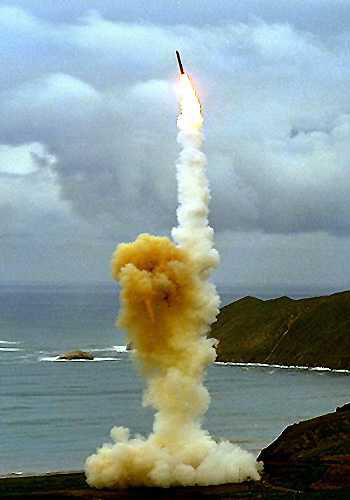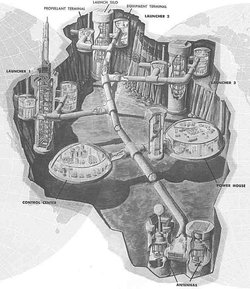Intercontinental ballistic missile
|
|

An intercontinental ballistic missile, or ICBM, is a very-long-range ballistic missile using a ballistic trajectory involving a significant ascent and descent, including sub-orbital flight. An ICBM differs little technically from other ballistic missiles such as intermediate-range ballistic missiles, short-range ballistic missiles, or the newly named theater ballistic missiles; these are differentiated only by maximum range. One particular weapon developed by the Soviet Union (FOBS) had a partial orbital trajectory, and unlike most ICBMs its target could not be deduced from its orbital flight path. It was decommissioned in compliance with arms control agreements, which address the maximum range of ICBMs and prohibit orbital or fractional-orbital weapons. Only three nations currently have operational ICBM systems: the United States, Russia, and China. However, other nations have ICBMs but not an organized ICBM system.
In 2002, the United States and Russia agreed in the SORT treaty to reduce their deployed stockpiles to not more than 2,200 warheads each.
| Contents |
Flight phases
The following flight phases can be distinguished:
- boost phase - 3 to 4 minutes (for a solid rocket shorter than for a liquid-propellant rocket); altitude at the end of this phase is 150 -200 km, typical burn-out speed is 7 km/s
- midcourse phase - ca. 25 minutes - suborbital flight in an elliptic orbit, i.e. the orbit is part of an ellipse with vertical major axis; the apogee (halfway the midcourse phase) is at an altitude of typically ca. 1200 km; the semi-major axis is between one half of the radius of the Earth and the radius; the projection of the orbit on the Earth's surface is a great circle - the missile may release a few independent warheads, a large number of decoys, and chaff
- reentry phase (starting at an altitude of 100 km) - 2 minutes
See also Missile Defense Agency.
History
The progenitor of the ICBM was the German A9/10, which was never developed but only proposed by Wernher von Braun. The progenitor of the IRBM was the German V2 (vergeltung, or "vengeance") rocket designed by von Braun that used liquid propellant and an inertial guidance system. It was launched from a mobile launcher in order to make it less susceptible to Allied air attacks. Following World War 2 von Braun and his lead scientist went to work directly for the US Army through Operation Paperclip developing the V2 into the Redstone IRBM and Jupiter IRBM. Due to treaty agreements the US was able to base these IRBMs in countries close to the USSR within strategic range. The USSR had no similar territory in the 1950s so under the direction of Sergei Korolev a crash programme to develop an ICBM began which at one stage consumed 5% of the entire Soviet military budget. Korolev was given access to captured V2 materials but evolved a distinct design, the R-7, that was declared 'operational' in 1957. Competition between the US armed services meant that each force developed its own ICBM programme slowing progress. The US's first ICBM was the Atlas operational in 1959. Both the R7 and Atlas required a large launch facility making them vulnerable to attack and could not be kept in a ready state. Early ICBMs formed the basis of many space launch systems. Examples include: Atlas, Redstone_rocket, Titan, R-7, and Proton. The UK built its own ICBM Bluesteel but it was never made operational due to the difficulty of finding a launch site away from population centres. Under the direction of Robert McNamara the US initiated the LGM-30 Minuteman, Polaris and Skybolt solid fuel ICBMs. Modern ICBMs tend to be smaller than their ancestors (due to increased accuracy and smaller and lighter warheads) and use solid fuels, making them less useful as orbital launch vehicles. Deployment of these systems was governed by the strategic theory of Mutually Assured Destruction.
In the 1970s development began of Anti Ballistic Missile Systems by both the US and USSR but these were restricted by treaty in order to preserve the value of the existing ICBM systems. President Ronald Reagan launched the Strategic Defence Initative as well as the MX and Midgetman ICBM programmes. This led to the agreement of a series of Strategic Arms Reduction Treaty negotiations.
Countries in the early stages of developing ICBMs have all used liquid propellants for simplicity's sake.
Modern ICBMs
Modern ICBMs typically carry multiple independently targetable reentry vehicles (MIRVs), each of which carries a separate nuclear warhead, allowing a single missile to hit multiple targets. MIRV was an outgrowth of the rapidly shrinking size and weight of modern warheads and the Strategic Arms Limitation Treaties which imposed limitations on the number of launch vehicles(SALT I and SALT II). It has also proved to be an "easy answer" to proposed deployments of ABM systems – it is far less expensive to add more warheads to an existing missile system than to build an ABM system capable of shooting down the additional warheads; hence, most ABM system proposals have been judged to be impractical. The only operational ABM systems were deployed in the 1970s, the US Safeguard ABM facility was located in North Dakota and was operational from 1975-1976. The USSR deployed its Galosh ABM system around Moscow in the 1970s, which remains in service.

Modern ICBMs tend to use solid fuel, which can be stored easily for long periods of time. Liquid-fueled ICBMs were generally not kept fueled all the time, and therefore fueling the rocket was necessary before a launch. ICBMs are based either in missile silos, which offer some protection from military attack (including, the designers hope, some protection from a nuclear first strike), or on submarines, rail cars or heavy trucks, which are mobile and therefore hard to find.
The low flying, guided cruise missile is an alternative to ballistic missiles.
Specific missiles
Land-based intercontinental ballistic missiles (ICBMs) and cruise missiles
The US Air Force currently operates just over 500 ICBMs at around 15 missile complexes located primarily in the northern Rocky Mountain states and the Dakotas. These are of the Minuteman III and Peacekeeper ICBM variants. Peacekeeper missiles are being phased out by 2005. All USAF Minuteman II missiles have been destroyed in accordance to START, and their launch silos sealed or sold to the public. To comply with the START II most US multiple independently targetable reentry vehicles, or MIRVs, have been eliminated and replaced with single warhead missiles. However, since the abandonment of the START II treaty, the U.S. is said to be considering retaining 800 warheads on 500 missiles.[1] (http://www.thebulletin.org/issues/nukenotes/mj04nukenote.html)
The United States Air Force awards two badges for performing duty in a nuclear missile silo. The Missile Badge is presented to commissioned officers while the Space and Missile Pin is awarded to silo ground and support personnel.
Sea-based ICBMs
- The US Navy currently has 14 Ohio-class SSBNs deployed. Each submarine is equipped with a complement of 24 Trident missiles, eight with Trident I missiles, and ten with Trident II missiles.
- The French Navy constantly maintains at least four active units, relying on two classes of nuclear-powered ballistic submarines (SSBN): the older Redoutable class, which are progressively decomissioned, and the newer Triomphant class. These carry 16 M45 missiles with TN75 warheads, and are scheduled to be upgraded to M51 nuclear missile around 2010.
Current and former US ballistic missiles
- Atlas (SM-65, CGM-16) former ICBM launched from silo, now the rocket is used for other purposes
- Titan I (SM-68, HGM-25A)
- Titan II (SM-68B, LGM-25C) - former ICBM launched from silo, now the rocket is used for other purposes
- Minuteman I (SM-80, LGM-30A/B, HSM-80)
- Minuteman II (LGM-30F)
- Minuteman III (LGM-30G) - launched from silo - as of June 28, 2004, there are 517 Minuteman III missiles in active inventory
- LG-118A Peacekeeper / MX (LG-118A, MX) - silo-based; 29 missiles were on alert at the beginning of 2004; all are to be removed from service by 2005.
- Midgetman - has never been operational - launched from mobile launcher
- Polaris A1, A2, A3 - (UGM-27/A/B/C) former SLBM
- Poseidon C3 - (UGM-73) former SLBM
- Trident - (UGM-93A/B) SLBM - Trident II (D5) was first deployed in 1990 and is planned to be deployed past 2020.
Soviet/Russian
Specific types of Soviet/Russian ICBMs include:
- SS-6 SAPWOOD / R-7 / 8K71
- SS-7 SADDLER / R-16
- SS-8 SASIN / R9
- SS-9 SCARP
- SS-11 SEGO
- SS-17 SPANKER
- SS-18 SATAN / R-36M2 / Voivode
- SS-19 STILLETO
- SS-20 SABER / RT-21M Pioneer / RSD-10
- SS-24 SCALPEL / RT-23
- SS-25 SICKLE / Topol
- SS-27 / Topol-M
People's Republic of China
Specific types of Chinese ICBMs called Dong Feng ("East Wind").
- DF-3 - cancelled. Program name transferred to a MRBM.
- DF-5 CSS-4 - only Chinese ICBM in operational status.
- DF-6 - cancelled
- DF-22 - cancelled by 1995.
- DF-31 CSS-X-9 - in development.
- DF-41 CSS-X-10 - in development.
Ballistic missile submarines
Specific types of ballistic missile submarines include:
- George Washinton class
- Ethan Allen class
- Lafayette class
- Benjamin Franklin class
- Ohio class
- Resolution class
- Vanguard class
- Typhoon class
- Delta IV class
- Redoutable class
- Triomphant class
- Xia class
- Additional Soviet/Russian ballistic missile submarines
See also
- The United States and weapons of mass destruction
- Russia and weapons of mass destruction
- China and weapons of mass destruction
- France and weapons of mass destruction
- SLBM
- Anti-ballistic missile
- Anti-Ballistic Missile Treaty
- nuclear disarmament
- nuclear navy
- nuclear warfare
- Force de frappe
- submarine
- Fractional Orbital Bombardment System
- Strategic triad
- U.S. Air Force Space Command
- ICBM Address
External links
- Estimated Strategic Nuclear Weapons Inventories (September 2004) (http://es.rice.edu/projects/Poli378/Nuclear/f04.stratg_invent.html)
|
Lists of Aircraft | Aircraft manufacturers | Aircraft engines | Aircraft engine manufacturers Airports | Airlines | Air forces | Aircraft weapons | Missiles | Timeline of aviation |
it:Missile balistico intercontinentale ms:Peluru berpandu balistik jarak benua ja:大陸間弾道ミサイル [[ru:Межконтинентальная баллистическаяѐ ё ракета]] sk:Medzikontinentálna balistická strela sv:Interkontinental ballistisk missil
